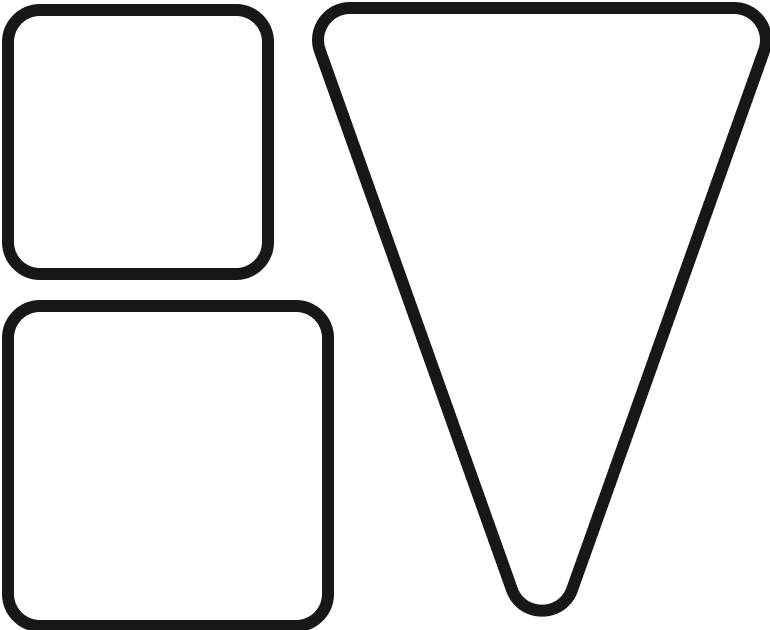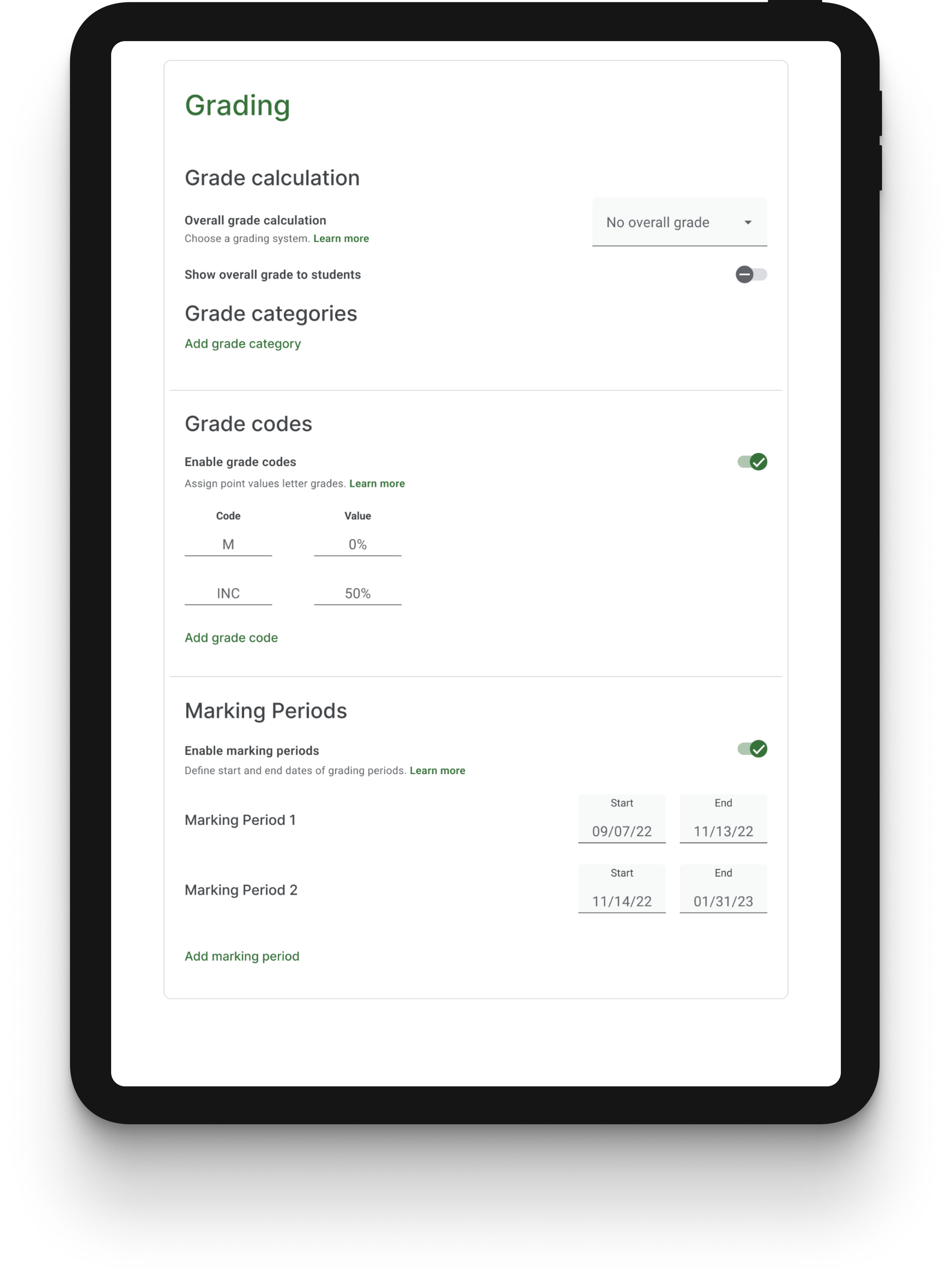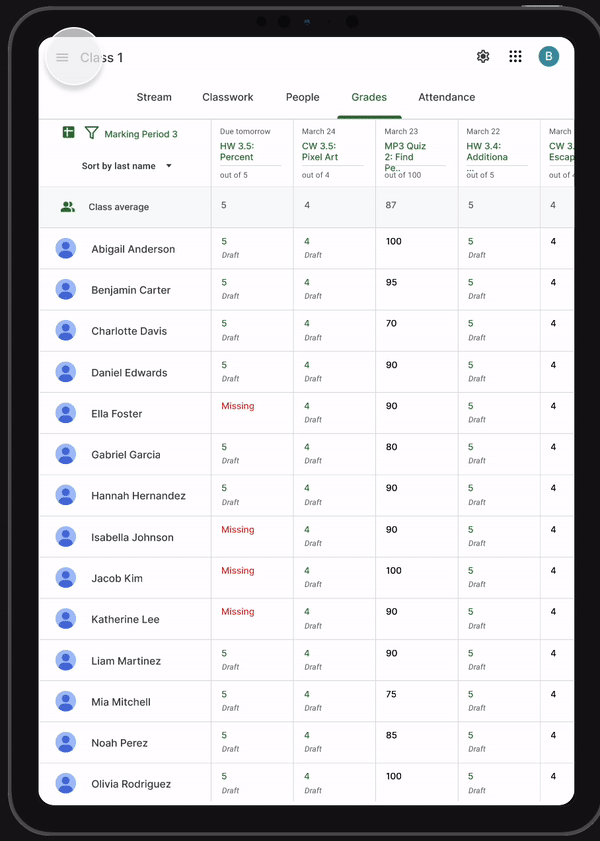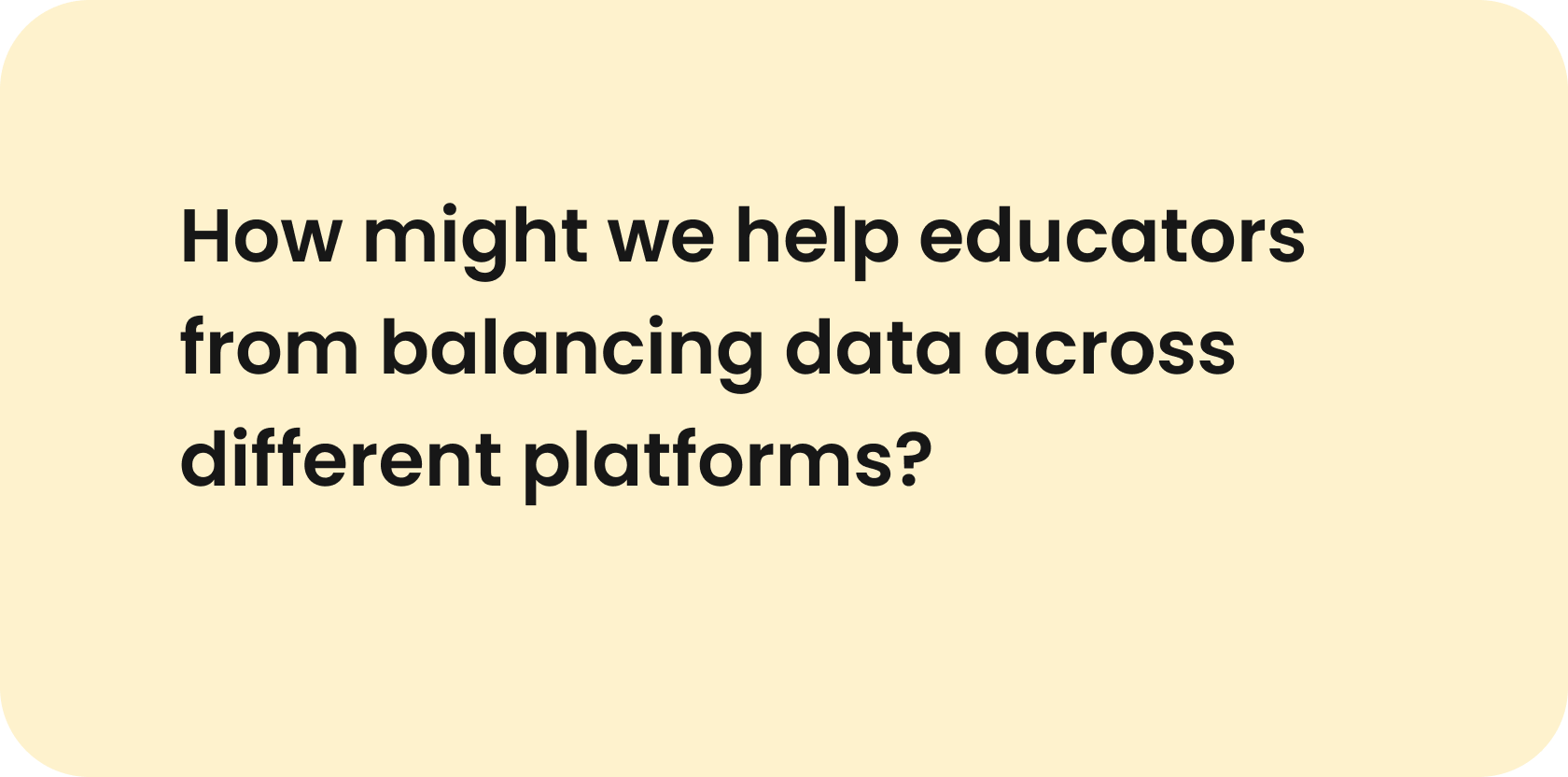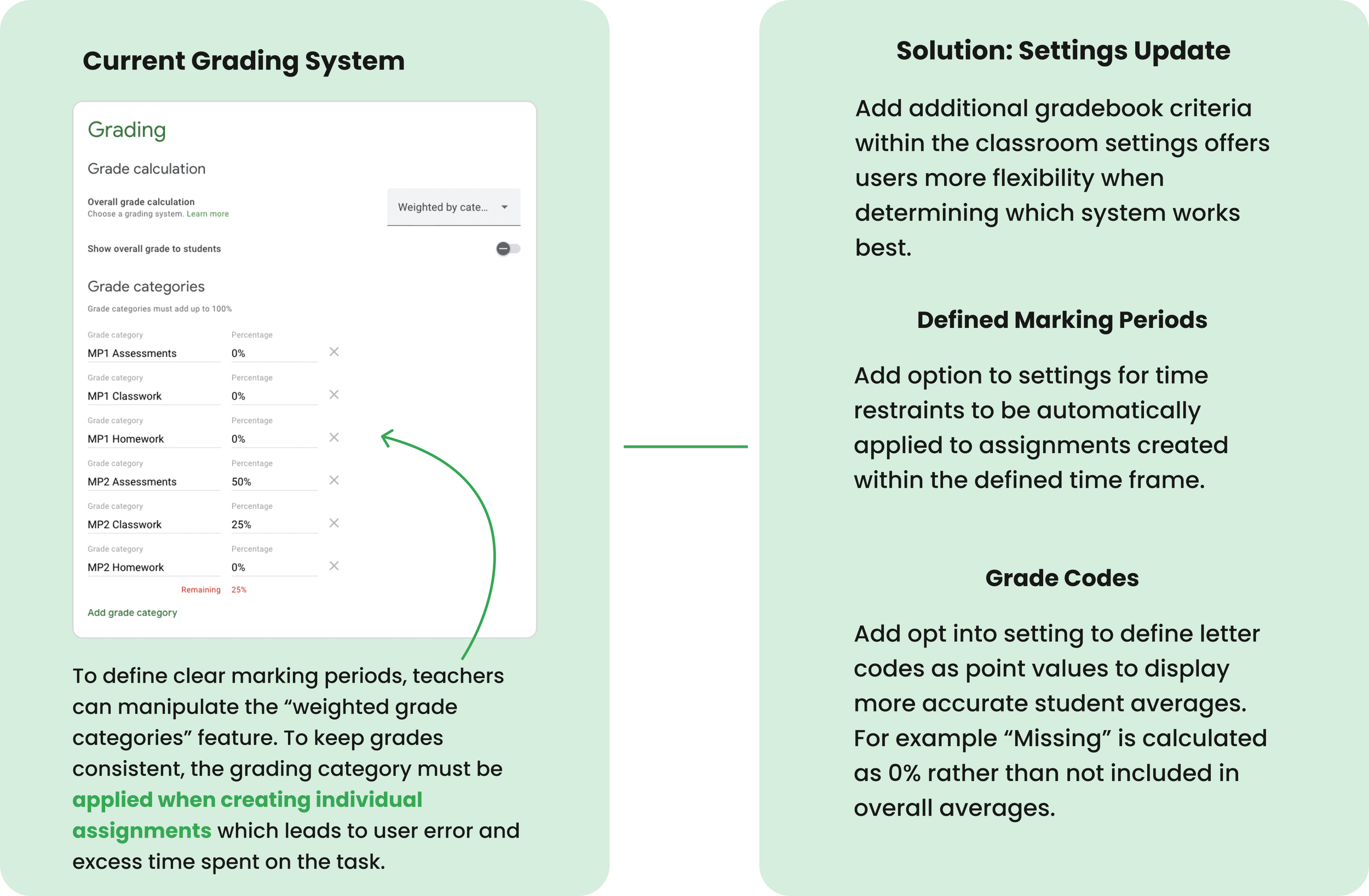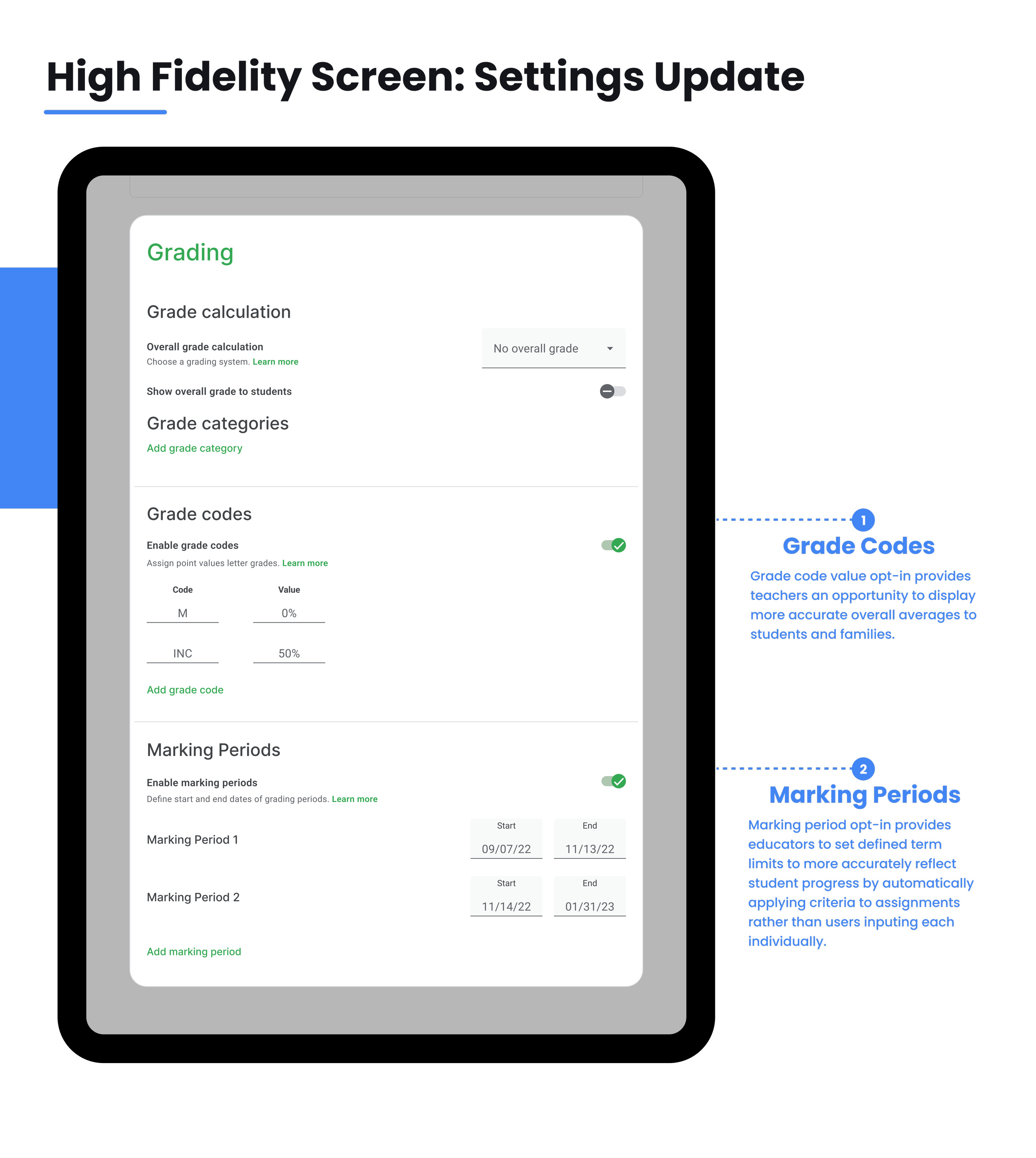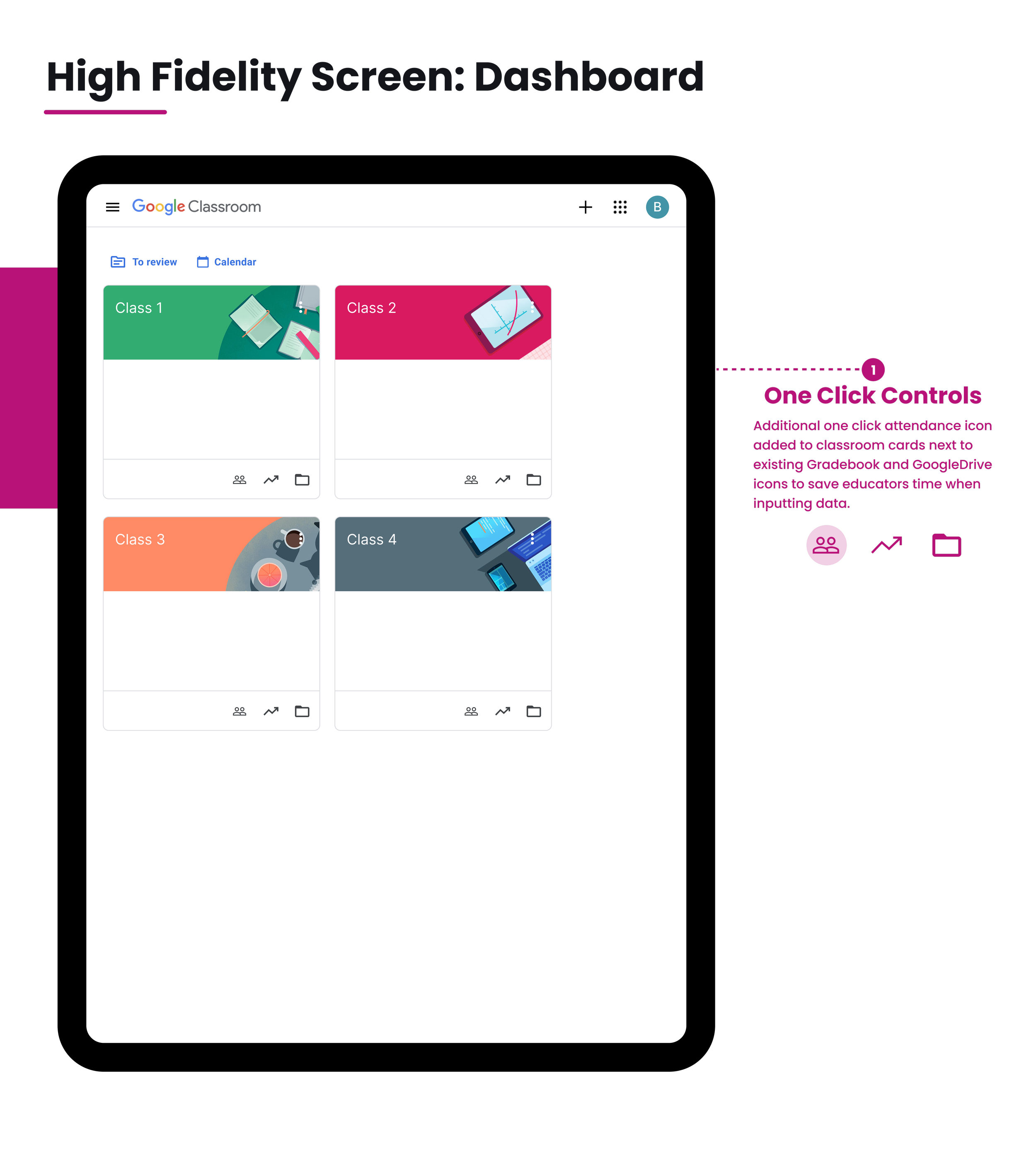Google Classroom
Features Update: Adding Attendance and Marking Periods to Streamline Classroom Management
Role
UX Designer
UX Researcher
Responsibilities
UX Research
Product Design
Prototyping
Usability Testing
Type
Independent Project
Duration
4 weeks
Tools Used:
Figma
Google Forms
FigJam
At its core, Google’s brand identity is centered around clean and intuitive design which is reflected in the current GoogleClassroom interface. However, it could be improved by adding features to streamline the lack of simplicity associated with creating a successful learning environment.
Features that teachers have been requesting is the ability to track attendance of their students and organize grades by marking periods. This case study outlines the design process for adding attendance and marking period features to Google Classroom.
Product Overview
Problem
The current GoogleClassroom system offers only essential features allowing assignments to be posted and submitted. Throughout the course of the year, the majority of materials added to a classroom is kept as a running list with little room for organizational hierarchy or nuance that exists within a real life classroom environment.
Goals
The prioritization during the development of a feature update focused on providing educators with time-saving methods for their daily tasks and offering students a more transparent view of their learning progress. The goal was to enhance the efficiency of educators' workflows and provide students with valuable insights into their educational journey.
Design Timeline
Target Audience
Google Classroom is primarily geared towards teachers and students in K-12 and higher education settings. Teachers can utilize the platform to efficiently manage their classrooms, create and distribute assignments, provide feedback, and foster communication with students. Meanwhile, students benefit from a centralized space where they can access course materials, submit assignments, engage in discussions, and collaborate with their peers.
Research
Quantitative Research
According to a report from EdWeek Market Brief, as of 2020, Google Classroom was the most widely used learning management system (LMS) in K-12 education in the United States
61%
of K-12 schools in the United States using the platform as their primary Learning Management system (EdWeek Market Brief, 2021)
54%
of teachers reported feeling overwhelmed by their job responsibilities (National Educators Association, 2020)
68%
of K-12 teachers reported that they were comfortable with the use of technology in their classroom (EdWeek Research Center , 2020)
80%
of K-12 schools in the US use some kind of digital learning management system (EdWeek Market Brief, 2021)
75%
of K-12 teachers reported that they were using more digital tools and resources in their instruction than they were five years ago (The Harris Poll, 2020)
150,000,000+
current users of GoogleClassroom worldwide, increased from 40 million users reported by Google in 2019
Primary Research
Competitive Analysis
In the education technology industry, Google Classroom faces competition from other learning management systems such as Edmodo, Moodle, and Canvas, which offer similar features and services to educators and students.
Canvas offers customizable dashboards, its ability to provide real-time feedback to students, and its mobile app, which allows students and teachers to access the platform on-the-go.
Moodle supports collaborative learning, its customizable design options, and its integration with external systems and services.
Edmodo has the ability to integrate with other educational apps and its focus on student engagement through gamification and badges. Additionally, Edmodo provides teachers with tools to create and share interactive lessons and assessments.
Interview Takeaways
1. Limited Customization
Teachers and students find that they are unable to customize the platform to suit their specific needs or preferences.
2. Limited Organization
Interview participants cited difficulty navigating and using the platform efficiently, especially if they are not familiar with other Google tools.
3. Limited Features
Interviewees reported that Google Classroom has limited features compared to other learning management systems, such as a lack of attendance tracking grading rubrics, or group collaboration features.
Based on thorough research, a single persona named "Tim" was created to represent various user groups. To gain a deeper understanding of Tim's experiences as a teacher using Google Classroom, an empathy map was meticulously developed. This allowed for a comprehensive visualization of Tim's engagement and enabled the design team to empathize with his needs and pain points more effectively.
Define
Persona: Tim
Empathy Map
Feature Prioritization
Proposed Updates
Attendance tracking to monitor progress based on absentees
Teacher facing assignment groupings when creating new posts to aid in differentiated instruction
Grade book customization by marking periods, and grade code values
When a student transfers classes, remove automated missing status for previous assignments.
Standards alignment input while creating assignments
In platform contact log with parents and guardians.
Priority Updates
Feature 1: Gradebook Update
80% of users surveyed felt gradebook customization features would provide a more accurate reflection of student progress.
Feature 2: Attendance Monitoring
90% of users surveyed felt attendance monitoring would streamline daily tasks and prevent the use of multiple platforms.
Task flows of teacher actions were categorized based on similarity. Actions either affected overall attendance monitoring or grade book capabilities. When analyzing the current available teacher user flow, any new input criteria in a “Create an Assignment” post needed to be enabled or disabled in the settings dashboard. Two task flows were updated: “Create an Assignment” and “‘Create’ Marking Periods.” Analyzing current actions helped in creating new feature task flows and understanding potential interruptions in procedures. It was determined that new features would interrupt the current create and assignment task flow with additional characteristics to help better individualize assignments.
Ideation
Task Flows
When creating low fidelity wireframes, the focus centered around which existing screens would be altered with improved features and the opportunity for entirely new screens. According to interview data, tablets were reportedly the most common device used within the school. When moving from low fidelity designs to high fidelity designs, tablets screens were explored.
Low Fidelity Wireframes
Low Fidelity Wireframes
Key Screens
Attendance Monitoring
Four participants provided feedback for usability testing. Participants expressed appreciation for the enhanced customization options available in the updated attendance feature. They found the ability to personalize attendance without having to juggle multiple platforms highly beneficial. This feature allowed teachers to quickly be provided with valuable insights for tracking student attendance and engagement. While the usability testing yielded mostly positive feedback, there were a few areas for further refinement. Some participants suggested minor adjustments to certain button placements and the visibility of certain information. These valuable suggestions help us fine-tune the feature and make it even more seamless and user-centric in future iterations.
Usability Testing Results
Gradebook Customization Settings
During the usability testing sessions, participants expressed overall satisfaction with the updated marking periods feature. They found the interface to be intuitive and easy to navigate, enabling them to seamlessly organize and track student progress throughout the academic year.
Participants appreciated the clear labeling and visual cues that made it easier to identify and differentiate between different grading periods. This enhancement improved their ability to effectively manage student evaluations and progress tracking.
Participants also praised the increased flexibility and customization options provided by the marking periods update. The ability to define grading periods according to their specific needs and easily modify them received positive feedback, enabling educators to align the system with their unique curricula.
While the usability testing revealed an overall positive response, a few participants suggested minor improvements. These suggestions included refining certain terminology and adding additional visual indicators to further enhance the clarity of the marking periods update. These insights will help refine the feature and ensure an even more seamless user experience for educators using Google Classroom.
Revision: Improve Grade book Organization by Date
While the existing Google Classroom lacks the ability to sort assignments by date in ascending order, a user expressed the desire for consistency with the new attendance feature, which presents assignments in ascending order (oldest first). To resolve this inconsistency, a sort button was introduced to the gradebook, allowing users to arrange assignments in ascending order based on their submission dates.
Revisions
Although participants responded positively to updates, the existing GoogleClassroom platform needs to expand functionality to provide better customization options for tracking student progress. A possible future roadmap includes the addition of standards-aligned assignments and progress monitoring pages. By incorporating standards-aligned assignments, educators will be able to align their curriculum with educational standards, ensuring targeted instruction and assessment. The progress monitoring pages will offer a comprehensive overview of individual student progress, facilitating data-driven decision-making and personalized learning. Additional personalization options will empower educators with robust tools for customization and progress tracking, enhancing the overall user experience and facilitating more effective teaching and learning.
Conclusion
Future Roadmap
Takeaways
Key takeaways for this project include the importance of maintaining consistency across features to enhance user understanding and streamlining the user interface to accommodate the additional functionalities seamlessly. These additions aimed to improve the overall user experience by providing teachers with efficient ways to track attendance and organize assignments, promoting a more organized and efficient workflow.
